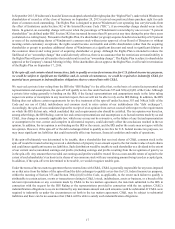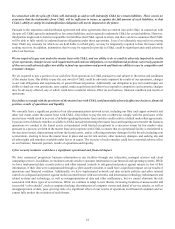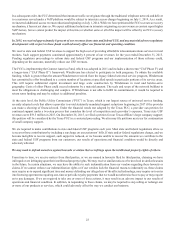Windstream 2015 Annual Report Download - page 99
Download and view the complete annual report
Please find page 99 of the 2015 Windstream annual report below. You can navigate through the pages in the report by either clicking on the pages listed below, or by using the keyword search tool below to find specific information within the annual report.17
In September 2015, Windstream’s board of directors adopted a shareholder rights plan (the “Rights Plan”), under which Windstream
shareholders of record as of the close of business on September 28, 2015 received one preferred share purchase right for each
share of common stock outstanding. The Rights Plan is designed to protect Windstream’s net operating loss carryforwards from
the effect of limitations under Section 382 of the Internal Revenue Code (“IRC”), if an ownership change should occur in the
future. In general, an ownership change will occur when the percentage of Windstream’s ownership by one or more “5-percent
shareholders” (as defined under IRC Section 382) has increased by more than 50 percent at any time during the prior three years
(calculated on a rolling basis). Pursuant to the Rights Plan, if a shareholder (or group) acquires beneficial ownership of 4.9 percent
or more of the outstanding shares of Windstream’s common stock without prior approval of our Board of Directors or without
meeting certain customary exceptions, the rights would become exercisable and entitle shareholders (other than the acquiring
shareholder or group) to purchase additional shares of Windstream at a significant discount and result in significant dilution in
the economic interest and voting power of acquiring shareholder or group. Although the Rights Plan is intended to reduce the
likelihood of an “ownership change” that could adversely affect us, there is no assurance that the restrictions on transferability in
the Rights Plan will prevent all transfers that could result in such an “ownership change”. The Rights Plan is subject to shareholder
approval at the Company’s Annual Meeting in May. If the shareholders do not approve the Rights Plan, it will result in termination
of the Rights Plan on September 17, 2016.
If the spin-off, and certain related transactions, fails to qualify as a tax-free transaction for U.S. federal income tax purposes,
we could be subject to significant tax liabilities and, in certain circumstances, we could be required to indemnify CS&L for
material taxes pursuant to indemnification obligations that we entered into with CS&L.
We received a private letter ruling from the IRS (the “IRS Ruling”) to the effect that, on the basis of certain facts presented and
representations and assumptions, the spin-off will qualify as tax-free under Sections 355 and 368(a)(1)(D) of the Code. Although
a private letter ruling generally is binding on the IRS, if the factual representations and assumptions made in the letter ruling
request are untrue or incomplete in any material respect, then we will not be able to rely on the IRS Ruling. In addition, the IRS
Ruling does not address certain requirements for tax-free treatment of the spin-off under Sections 355 and 368(a)(1)(D) of the
Code and our use of CS&L indebtedness and common stock to retire certain of our indebtedness (the “debt exchanges”).
Accordingly, the spin-off was conditioned upon the receipt of a tax opinion from our tax counsel with respect to the requirements
on which the IRS did not rule, which concluded that such requirements also should be satisfied. The tax opinion was based on,
among other things, the IRS Ruling, current law and certain representations and assumptions as to factual matters made by us and
CS&L. Any change in currently applicable law, which may or may not be retroactive, or the failure of any factual representation
or assumption to be true, correct and complete in all material respects, could adversely affect the conclusions reached in the tax
opinion. In addition, the tax opinion is not binding on the IRS or the courts, and the IRS and/or the courts may not agree with the
tax opinion. However, if the spin-off or the debt exchanges failed to qualify as tax free for U.S. federal income tax purposes, we
may incur significant tax liabilities that could materially affect our business, financial condition and results of operations.
If the spin-off ultimately was determined to be taxable, then a shareholder that received shares of CS&L common stock in the
spin-off would be treated as having received a distribution of property in an amount equal to the fair market value of such shares
and could incur significant income tax liabilities. Such distribution would be taxable to such shareholder as a dividend to the extent
of our current and accumulated earnings and profits (including earnings and profits resulting from the recognition of gain by us
in the spin-off). Any amount that exceeded our earnings and profits would be treated first as a non-taxable return of capital to the
extent of such shareholder’s tax basis in its shares of our common stock with any remaining amount being taxed as a capital gain.
In addition, if the spin-off were determined to be taxable, we would recognize taxable gain.
Under the terms of the tax matters agreement that we entered into with CS&L, CS&L is generally responsible for any taxes imposed
on us that arise from the failure of the spin-off and the debt exchanges to qualify as tax-free for U.S. federal income tax purposes,
within the meaning of Section 355 and Section 368(a)(1)(D) of the Code, as applicable, to the extent such failure to qualify is
attributable to certain actions, events or transactions relating to CS&L’s stock, indebtedness, assets or business, or a breach of the
relevant representations or any covenants made by CS&L in the tax matters agreement, the materials submitted to the IRS in
connection with the request for the IRS Ruling or the representations provided in connection with the tax opinion. CS&L’s
indemnification obligations to us are not limited by any maximum amount and such amounts could be substantial. If CS&L were
required to indemnify us under the circumstances set forth in the tax matters agreement, CS&L may be subject to substantial
liabilities and there can be no assurance that CS&L will be able to satisfy such indemnification obligations.
























